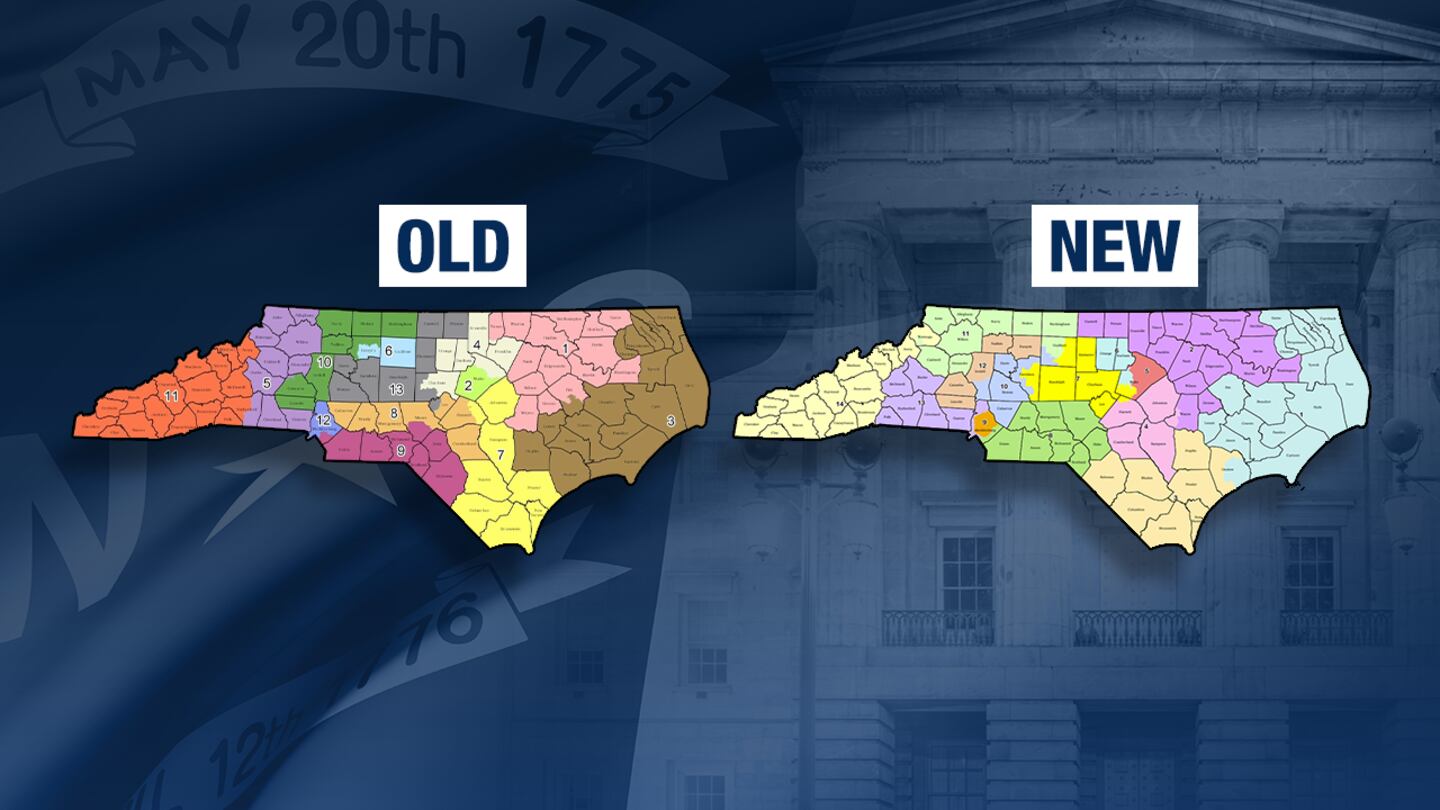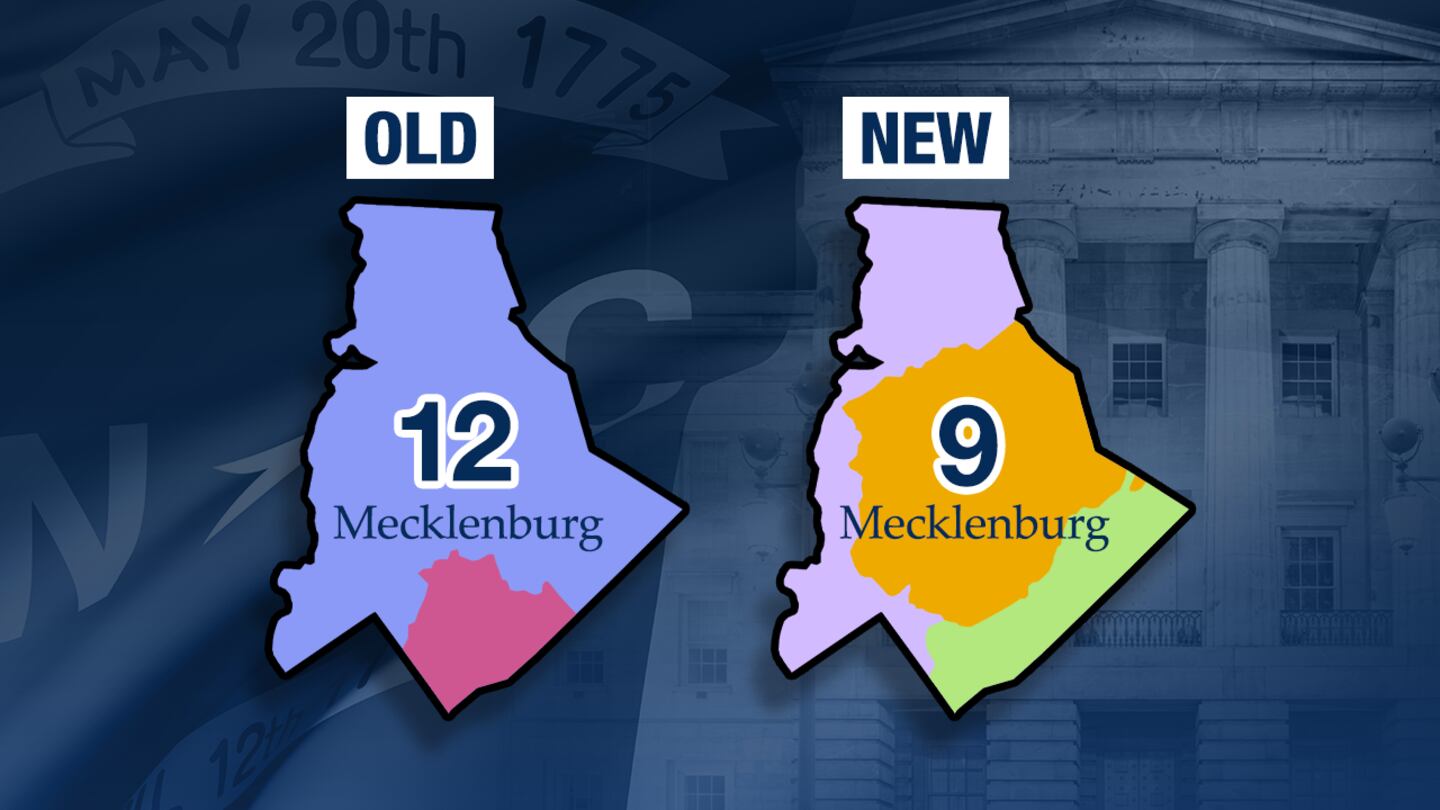RALEIGH, N.C. — You might see different candidates on your ballot when you vote this year after three North Carolina judges ruled a redrawn map can stand.
The decision will be appealed by the advocacy groups and voters — some backed by a national Democratic group — who challenged the new congressional and legislative lines in court. The next and final stop for the case is the state supreme court.
In the image below, the left shows what the congressional districts currently look like. The right shows what could be in place very soon.
Mecklenburg County will be split three ways and Channel 9 reporter Joe Bruno gave three examples of the impact if incumbents win re-election.
Starting in west Mecklenburg County -- If you vote at Garden Memorial Church on Election Day, you are impacted by the redistricting. Right now, Democrat Alma Adams represents the area but if the current map stands, those residents will be in the 13th congressional district. That’s a favored Republican district. The representatives with the new map could be Huntersville Mayor John Aneralla or Madison Cawthorn, who are among several Republican candidates who intend to run for this seat.
Heading over to south Charlotte at the Carmel Presbyterian Church Election Day voting site, the current representative is Dan Bishop but if the map stays as it is, the new representative will be Alma Adams.
And at Mint Hill’s Town Hall, if you vote there on Election Day, your representative is Alma Adams, but soon it will be Dan Bishop.
The three-judge panel ruled Tuesday the maps do not illegally favor the Republican party. But Democrats argued even in “good” years, the lines were drawn in a way that guarantees the GOP to win 10 of 14 Congressional seats.
“It undermines voter sense that they have any say,” said Sen. Natasha Marcus, who represents Davidson. “Where are we left when voters feel like there’s no point in voting because Republican mapmakers have rigged the maps to win every time, no matter what we do?”
Republicans called the redistricting process fair and transparent, arguing they didn’t use political or racial data to draw the new boundaries.
“Following the rules that have been set forth by the courts,” said NCGOP Michael Whatley. “It’s good to see that that process was followed. We think that these are fair maps, and glad to see that the trial court agrees.”
Judges let North Carolina GOP redistricting plans stand
A North Carolina judicial panel refused Tuesday to throw out redistricting maps drawn by the Republican-controlled General Assembly, rejecting arguments that the lines were illegally politically stacked for the GOP.
The unanimous decision by the three trial judges, which followed a quick trial last week, will be appealed by the advocacy groups and voters — some backed by a national Democratic group — who challenged the new congressional and legislative lines in court.
The state Supreme Court, which is expected to have the final say on the maps, had ordered the trial judges to rule by Tuesday, apparently to discourage further delays in the 2022 election schedule.
The justices had already postponed the scheduled March 8 primary to May 20 and suspended candidate filing while the trial judges heard testimony and received filings. Maps would need to be finalized — whether under the enacted plans or with court-ordered changes — by Feb. 18 to carry out a mid-May primary, according to the State Board of Elections.
The ruling- NC maps can stand. Appeal to NC Supreme Court likely #ncpol pic.twitter.com/OWxhMwJRRO
— Joe Bruno (@JoeBrunoWSOC9) January 11, 2022
“At the end of the day, after carefully and fully conducting our analysis, it is clear that plaintiffs’ claims must fail,” Superior Court Judges Graham Shirley, Nathaniel Poovey and Dawn Layton wrote in the 260-page ruling.
With the decision, the judges showed they weren’t persuaded by the plaintiffs’ evidence from mathematicians and other political researchers. The witnesses declared the boundaries were manipulated according to the political leanings and the racial composition of voters so that, even in good Democratic years, the GOP could hold 10 of the state’s 14 U.S. House seats as well as state House and Senate majorities that are almost unbreakable. That contrasts with North Carolina’s statewide elections, which are usually closely divided.
One mathematician, Wesley Pegden of Carnegie Mellon University, declared his algorithmic analysis found mapmakers intentionally chose maps crafted more carefully for GOP advantage than at least 99.9% — and in some cases 99.999% — of all possible alternatives. The math experts painted a picture of their algorithms showing there was little chance that the Republican advantages were anything other than intentional violations of the state constitution.
Republicans currently hold eight of the state’s 13 congressional seats, so the state’s GOP remap could help the party take back the U.S. House. North Carolina gained a House seat for the next decade based on population growth in the 2020 census.
“This court neither condones the enacted maps nor their anticipated potential results,” the judges wrote. “Despite our disdain for having to deal with issues that potentially lead to results incompatible with democratic principles and subject our state to ridicule, this court must remind itself that these maps are the result of a democratic process.”
Republicans spent the trial maintaining that the redistricting process was fair and transparent and prohibited the use of racial and political data. Redistricting is in the purview of the legislature, GOP lawyers said, which is allowed under the rules to take some partisan advantage into consideration. Instead, they added, the plaintiffs want to replace the will of lawmakers with the will of computers and the discretion of its algorithm developers with maps that favor Democrats.
“To accept the plaintiffs’ arguments that the maps are unconstitutional on the theories advanced would necessarily mean that no partisan gerrymandering is allowed as no voter should suffer from the effects of the same,” the panel continued, stating that is contrary to state and U.S. Supreme Court precedent.
A similar panel of trial judges reached a different outcome in 2019, declaring there was evidence that GOP legislators created extreme partisan gerrymanders when drawing U.S. House districts in 2016 and legislative districts in 2017. The legislature redrew the maps in time for the 2020 elections. The U.S. Supreme Court had decided earlier in 2019 that it wouldn’t get involved in partisan redistricting claims, but the justices left the door open for state courts to intervene.
“We are confident that the people of North Carolina will ultimately prevail in our fight for fair maps,” Bob Phillips with Common Cause North Carolina — one of the lawsuits’ plaintiffs — said after the ruling’s release. The group’s attorneys vowed to appeal.
Poovey and Shirley are registered Republicans, while Layton is a Democrat. Four of the seven state Supreme Court justices are registered Democrats, but there are already efforts to have one of the four recuse himself from the redistricting case.
>> Remember, you can watch our radar/newscasts anytime at home on Roku, Amazon Fire and Apple TV
Republicans have asked Associate Justice Sam Ervin IV, a registered Democrat, to stay out of the deliberations as the only sitting member running for reelection this year. They say his decisions could affect the general election and “his own electability and creates a situation where his own impartiality may reasonably be questioned.”
The Associated Press contributed to this report.
(Watch below: Charlotte City Council approves redistricting map including Hidden Valley changes)
The Associated Press contributed to this report.
©2022 Cox Media Group








